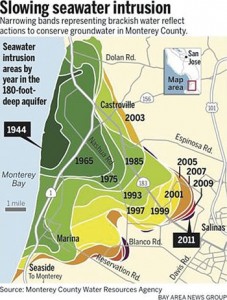By Kim Anderson, General Manager Soquel Creek Water District
Sandy Lydon, local historian, wrote The History of the Soquel Creek Water District 1961-1988 in which much of the early information presented here is documented. I have no doubt that someday in the near future Mr. Lydon will have the opportunity to update our history complete with the steps we’ve taken to secure a stable and sustainable water supply for our community.
Soquel Creek Dam Consideration

In 1961, after several community meetings, as well as a public vote, the Soquel Creek Water District was formed. The Soquel Creek Dam issue surfaced for a third time in 1963 when the Army Corps of Engineers felt it would be a good flood protection project. By 1964, in the face of very vocal opposition, the Soquel Creek Reservoir died yet again. In the late 1960’s, the US Geological Survey (USGS) studied the District’s underground aquifers and determined that the District could safely pump up to 7,700 acre feet of water each year. Growth projections in mid-county made it prudent to look again at future water needs since at that time the average customer’s use was nearly 300 gallons per day.
Safe Pumping Level Confusion
In 1973, supplemental supply through a reservoir was again considered. Projections were that this additional water would be needed to meet supply after 1997, but that still meant the District had enough water for the next 20 years. But in 1978, a second USGS report identified seawater intrusion and stated the safe pumping level was actually 4,000 rather than 7,700 acre feet per year.
The Board sought a review of all the previous reports and was informed that the latest report was flawed. The review found no indication of seawater intrusion or overdraft, but recommended development of a groundwater monitoring program. The Board was also told that they could safely pump about 14,000 acre-feet per year. While this report stated we had more available water, it again identified a need for additional future supplies.
Seawater Intrusion Monitoring
In 1994, those monitoring wells indicated that groundwater levels were falling and seawater intrusion was occurring. This lead to the formation of a citizen advisory group, much like the one currently being formed in the City of Santa Cruz. In 1997 this citizen group identified a need for supplemental supply and recommended looking at a Soquel Creek diversion, desalination and recycled water options. The group also recommended enhanced water conservation and this was the beginning of the District’s and the community’s outstanding conservation efforts.
Desalination Partnership
As the District started looking again at the various options for supplemental supply, they also started seeing their conservation efforts paying off. By 2006, the projected water need was adjusted down by approximately 2,000 acre-feet. Again, desalination, recycled water and Soquel Creek diversion were identified as options for supplemental supply. The District and the city started to move forward with plans for a joint supplemental supply project, and those efforts continued until August of last year when the city stepped back to reevaluate their options.
Current Supply Situation
Even with some new development, in the past ten years water use has been reduced by 25%. And when progress slowed on the joint supplemental supply project, the District regrouped and started evaluating other options. That’s where we are right now. We believe we can safely pump about 4,000 acre-feet per year once the basin is refilled, but we have to reduce pumping by 35% for at least 20 years to refill the basin. Clearly, it has been a very busy few decades for the District, and will continue to be so into the near future.